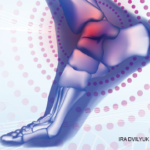Machine learning is a tool that may help pediatric rheumatologists distinguish between different subtypes of juvenile idiopathic arthritis (JIA) and predict treatment response.


The Children’s Hospital at Montefiore Pediatric Rheumatology Fellowship Program: Alisha Akinsete, MD; Malki Peskin, MD; & Jessica Perfetto, MD |
Machine learning is a tool that may help pediatric rheumatologists distinguish between different subtypes of juvenile idiopathic arthritis (JIA) and predict treatment response.

Ohio State University Rheumatology Fellowship Program: Nina Couette, DO; Jesse Reisner, DO; & Sheryl Mascarenhas, MD, Fellowship Program Director |
Editor’s note: RheumMadness is the place for everyone crazy about rheumatology to connect, collaborate, compete and learn together. During RheumMadness, rheumatology concepts represent teams that compete against each other in a tournament, much like basketball teams do in the NCAA’s March Madness tournament. In a series for The Rheumatologist, readers will get a chance to…

University of Texas Southwestern Rheumatology Fellowship Program: Kubra Bugdayli, MD; Brett Capel, MD; Yusuf Chao, MD; Melissa DeFoe, MD; Daniel Emesiani, MD; Joad Eseddi, MD; Nagendra Pokala, MD; Komal Patel, MD; Bonnie Bermas, MD; Haidy Galous, MD; Andreas Reimold, MD; & Guillermo Andres Quiceno, MD |
Dalmatians have defects in the renal tubular reabsorption of filtered urate and the hepatic conversion of uric acid to allantoin that may provide unique insights into uric acid homeostasis, with implications for the treatment and management of gout.

Wake Forest School of Medicine Rheumatology Fellowship Program: Khiem Vu, MD; Alyssa Strazanac, MD; John Herion, DO; & Rami Diab, MD |
Daily living, such as walking, jumping and going up stairs, can be difficult for patients with osteoarthritis (OA). Research on the regenerative limbs of the axolotl and the human ankle provides insights into the potential of this process in humans and its implications for hip, knee and ankle OA.

The research presented at ACR Convergence 2021 had a broad scope. Below are details on three studies that addressed cardiovascular safety in treat-to-target strategies, phase 2 study results on the efficacy of tigulixostat and the impact of patient preference on treatment adherence. Take our quiz after you read this article. Treat to Target Abstract L06:…

Residents from the RheumMadness Leadership Team: Michael Macklin, MD, PharmD; Ben Kellogg, MD; Lauren He, MD; & David Leverenz, MD |
According to research, Pim kinases contribute to the pathogenesis of rheumatoid arthritis (RA) and may have the therapeutic potential for inhibition in patients with RA.

Mass General Hospital Rheumatology Fellowship Program: Guy Katz, MD; Ian Cooley, MD; Duncan Moore, MD; Jacquelyn Nestor, MD, PhD; & Steven Witte, MD, PhD |
CD19 chimeric antigen receptor T (CAR-T) cell therapies may have the potential to treat rheumatic diseases in which current therapeutic options are limited, such as lupus, interstitial lung disease and systemic sclerosis.

The UNC Rheumatology Fellowship Program: Leah Bettner, MD; Shruti Chandramouli, MD; Christopher Overton, MD; Astia Allenzara, MD; Michael Cunningham, MD; & Luis Palomino, MD |
Neutrophil extracellular traps (NETs) contribute to the pathogenesis of multiple autoimmune diseases. And research has shown that patients with antiphospholipid syndrome (APS) have higher levels of circulating anti-NET antibodies than healthy controls, indicating a potential biomarker.

COVID-19 vaccination, treatments for rheumatic disease and more—the Late-Breaking Abstracts session of ACR Convergence 2021 highlighted six studies with implications for rheumatology.
In February A&R, Penso et al. reported on the results of their study, which explored whether patients with psoriasis, PsA and AS have a higher risk of developing IBD when treated with an IL-17 inhibitor compared with apremilast, a phosphodiesterase 4 (PDE4) inhibitor, or etanercept, a TNF inhibitor.